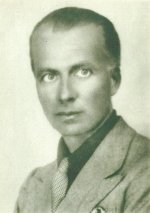|
|
Giacinto Scelsi
Gavin Thomas introduces the work of Giacinto Scelsi (1905--1988).
Overview
Count Giacinto Scelsi D’Ayala Valva, aristocrat, poet
and composer, was one of the twentieth century’s more
unusual musicians.
Born in 1905, he grew up in the Scelsi family’s ancestral castle
at Valva, near Naples, where his studies concentrated --
according to the composer’s own testimony -- on the noble
pursuits of fencing, Latin and chess.
His youthful enthusiasms also included the piano, an instrument for which
he formed a lifelong affection and at which he developed the
habit of improvising for hours at a time -- a strange anticipation of his
later composing method.
Although Scelsi never received any formal musical training, as
a young man he frequented the house of Respighi in Rome, became an enthusiast
for the Futurist music of Luigi Russolo, and later
studied briefly in Vienna with a pupil of Schoenberg, writing the
first 12-note music to be composed by an Italian. He
subsequently lived in London, where he married a cousin of the queen,
and Paris, where he published three volumes of Surrealist poetry in French
and established a minor reputation as a maverick composer whose influences
ranged from Futurism to Berg and Scriabin.
During these years he also travelled in Asia, in particular to India and Tibet,
journeys which would later prove of great significance in his artistic development.
The full facts of Scelsi’s life are imperfectly known. Following World
War II it appears he suffered an extended nervous breakdown during which,
as he would later proudly announce, “I forgot everything I ever knew about music”.
During his recovery, Scelsi fell into the habit of calming his mind by playing
single notes over and over on the piano, a form of musical auto-therapy which was,
improbably, to form the basis of his mature compositional style.
He also became an adept of Buddhism, meditating three times daily, adding
a Zen symbol to his signature and refusing to allow his photograph to be taken.
In 1959, out of his one-note improvisations, came the seminal Quattro pezzi chiascuno su una nota sola
(“Four pieces each one on a single note”), the first unequivocal demonstration
of Scelsi’s concern with what he called the “three-dimensional” quality of sound.
Each
piece takes as its starting (and ending) point a single note -- a radical
paring-down of musical subject matter which focuses attention inward,
making the listener concentrate on what musical sound is, rather than what it does.
The obvious comparison is with the Eastern musics Scelsi admired – whether the
Indian raga or the Tibetan tantra, with their hypnotic concentration on a single elemental
sonority -- yet Scelsi’s strange genius lifts this
and all his later work far above the level of mere musical tourism,
creating a unique soundworld which is unplaceable in any tradition except its own.
Though none of Scelsi’s subsequent works shows quite the pyrrhic
simplicity of the Quattro pezzi, all are based on what
is essentially material of extreme spareness. It’s music which
is totally lacking in theme, melody, rhythm and (often) harmony, but which
instead confronts the listener with the phenomenom of pure sound in
seemingly natural and spontaneous evolution -- the paradox is that
(in his finest works at least) Scelsi manages to conjure
such luminous musical effects from even the simplest of
note-combinations.
Always an extremely prolific composer, Scelsi’s later music
features many pieces for strings especially, including a number
of string quartets and the wonderful “violin concerto” Anahit,
and also for wind instruments, such as the haunting Kya
for clarinet and ensemble -- though he gave up writing for his
once favoured instrument, the piano, finding its fixed
tuning and uniform sound colour too inflexible for his musical needs.
Scelsi also became famous not only for his unique musical style, but
also for his unusual working methods, whereby pieces were first
improvised -- either by the composer himself at the keyboard or
in collaboration with sympathetic performers -- and then written down
by amanuenses (in a strange twist, one of Scelsi’s assistants,
the Italian composer Vieru Tosatti, later claimed that he rather than
Scelsi was the true author of the works).
Scelsi stopped composing around 1975, but enjoyed belated fame as musicians
from all over the world discovered his work.
Article and review pages originally published in The Rough Guide
to Classical Music
Buy Sheet Music by Scelsi
|